| Article ID | Journal | Published Year | Pages | File Type |
|---|---|---|---|---|
| 4702480 | Geochimica et Cosmochimica Acta | 2013 | 12 Pages |
A new method for K–Ar dating using a double isotope dilution technique is proposed and demonstrated. The method is designed to eliminate known difficulties facing in situ dating on planetary surfaces, especially instrument complexity and power availability. It may also have applicability in some terrestrial dating applications. Key to the method is the use of a solid tracer spike enriched in both 39Ar and 41K. When mixed with lithium borate flux in a Knudsen effusion cell, this tracer spike and a sample to be dated can be successfully fused and degassed of Ar at <1000 °C. The evolved 40Ar∗/39Ar ratio can be measured to high precision using noble gas mass spectrometry. After argon measurement the sample melt is heated to a slightly higher temperature (∼1030 °C) to volatilize potassium, and the evolved 39K/41K ratio measured by Knudsen effusion mass spectrometry. Combined with the known composition of the tracer spike, these two ratios define the K–Ar age using a single sample aliquot and without the need for extreme temperature or a mass determination. In principle the method can be implemented using a single mass spectrometer.Experiments indicate that quantitative extraction of argon from a basalt sample occurs at a sufficiently low temperature that potassium loss in this step is unimportant. Similarly, potassium isotope ratios measured in the Knudsen apparatus indicate good sample-spike equilibration and acceptably small isotopic fractionation. When applied to a flood basalt from the Viluy Traps, Siberia, a K–Ar age of 351 ± 19 Ma was obtained, a result within 1% of the independently known age. For practical reasons this measurement was made on two separate mass spectrometers, but a scheme for combining the measurements in a single analytical instrument is described. Because both parent and daughter are determined by isotope dilution, the precision on K–Ar ages obtained by the double isotope dilution method should routinely approach that of a pair of isotope ratio determinations, likely better than ±5%.
